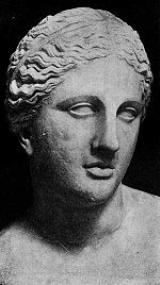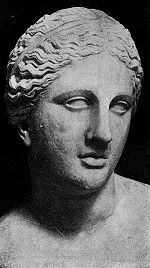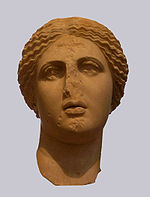
Phryne
Encyclopedia

Hetaera
In ancient Greece, hetaerae were courtesans, that is to say, highly educated, sophisticated companions...
(courtesan
Courtesan
A courtesan was originally a female courtier, which means a person who attends the court of a monarch or other powerful person.In feudal society, the court was the centre of government as well as the residence of the monarch, and social and political life were often completely mixed together...
) of Ancient Greece
Ancient Greece
Ancient Greece is a civilization belonging to a period of Greek history that lasted from the Archaic period of the 8th to 6th centuries BC to the end of antiquity. Immediately following this period was the beginning of the Early Middle Ages and the Byzantine era. Included in Ancient Greece is the...
(4th century BC).
Early life
Her real name was Mnesarete (Μνησαρέτη "commemorating virtue"), but owing to her yellowish complexion she was called Phryne "Toad", a name given to other courtesans. She was born at ThespiaeThespiae
Thespiae was an ancient Greek city in Boeotia. It stood on level ground commanded by the low range of hills which runs eastward from the foot of Mount Helicon to Thebes, near modern Thespies.-History:...
in Boeotia
Boeotia
Boeotia, also spelled Beotia and Bœotia , is one of the regional units of Greece. It is part of the region of Central Greece. It was also a region of ancient Greece. Its capital is Livadeia, the second largest city being Thebes.-Geography:...
, but seems to have lived at Athens
Athens
Athens , is the capital and largest city of Greece. Athens dominates the Attica region and is one of the world's oldest cities, as its recorded history spans around 3,400 years. Classical Athens was a powerful city-state...
. She acquired so much wealth by her extraordinary beauty that she offered to rebuild the walls of Thebes
Thebes, Greece
Thebes is a city in Greece, situated to the north of the Cithaeron range, which divides Boeotia from Attica, and on the southern edge of the Boeotian plain. It played an important role in Greek myth, as the site of the stories of Cadmus, Oedipus, Dionysus and others...
, which had been destroyed by Alexander the Great (336 BC), on condition that the words destroyed by Alexander, restored by Phryne the courtesan, were inscribed upon them (Athenaeus
Athenaeus
Athenaeus , of Naucratis in Egypt, Greek rhetorician and grammarian, flourished about the end of the 2nd and beginning of the 3rd century AD...
13.591d). The authorities turned down her offer.
Fame
She was famously beautiful. On the occasion of a festival of PoseidonPoseidon
Poseidon was the god of the sea, and, as "Earth-Shaker," of the earthquakes in Greek mythology. The name of the sea-god Nethuns in Etruscan was adopted in Latin for Neptune in Roman mythology: both were sea gods analogous to Poseidon...
at Eleusis, she laid aside her garments, let down her hair, and stepped nude into the sea in the sight of the people, thus suggesting to the painter Apelles
Apelles
Apelles of Kos was a renowned painter of ancient Greece. Pliny the Elder, to whom we owe much of our knowledge of this artist rated him superior to preceding and subsequent artists...
his great picture of Ἀφροδίτη Ἀναδυομένη Aphrodite Anadyomene (also portrayed at times as this Venus Anadyomene
Venus Anadyomene
Venus Anadyomene was one of the iconic representations of Aphrodite, made famous in a much-admired painting by Apelles, now lost, but described in Pliny's Natural History, with the anecdote that the great Apelles employed Campaspe, a mistress of Alexander the Great, for his model...
), for which Phryne herself sat as model. Other works of art from the period are alleged to be modeled after Phryne. She was also (according to some) the model for the statue of the Aphrodite of Knidos
Aphrodite of Knidos
The Aphrodite of Cnidus was one of the most famous works of the ancient Greek sculptor Praxiteles of Athens . It and its copies are often referred to as the Venus Pudica type, on account of her covering her naked vulva with her right hand...
by Praxiteles
Praxiteles
Praxiteles of Athens, the son of Cephisodotus the Elder, was the most renowned of the Attic sculptors of the 4th century BC. He was the first to sculpt the nude female form in a life-size statue...
. A statue of Phryne, the work of Praxiteles, was placed in a temple at Thespiae by the side of a statue of Aphrodite by the same artist. Diogenes Laertius
Diogenes Laertius
Diogenes Laertius was a biographer of the Greek philosophers. Nothing is known about his life, but his surviving Lives and Opinions of Eminent Philosophers is one of the principal surviving sources for the history of Greek philosophy.-Life:Nothing is definitively known about his life...
narrates a failed attempt Phryne made on the virtue of the philosopher Xenocrates
Xenocrates
Xenocrates of Chalcedon was a Greek philosopher, mathematician, and leader of the Platonic Academy from 339/8 to 314/3 BC. His teachings followed those of Plato, which he attempted to define more closely, often with mathematical elements...
.
Trial
When accused of profaning the Eleusinian MysteriesEleusinian Mysteries
The Eleusinian Mysteries were initiation ceremonies held every year for the cult of Demeter and Persephone based at Eleusis in ancient Greece. Of all the mysteries celebrated in ancient times, these were held to be the ones of greatest importance...
, she was defended by the orator Hypereides
Hypereides
Hypereides or Hyperides was a logographer in Ancient Greece...
, one of her lovers. The speech for the prosecution was written by Anaximenes of Lampsacus
Anaximenes of Lampsacus
Anaximenes of Lampsacus was a Greek rhetorician and historian.-Rhetorical works:Anaximenes was a pupil of Zoilus and, like his teacher, wrote a work on Homer. As a rhetorician, he was a determined opponent of Isocrates and his school...
according to Diodorus Periegetes (Athenaeus 13.591e). When it seemed as if the verdict would be unfavourable, Hypereides tore open her robe and displayed her breast
Breast
The breast is the upper ventral region of the torso of a primate, in left and right sides, which in a female contains the mammary gland that secretes milk used to feed infants.Both men and women develop breasts from the same embryological tissues...
s, which so moved her judges that they acquitted her. According to others, she herself removed her clothing. The judges' change of heart was not simply because they were overcome by the beauty of her nude body, but because such unusual physical beauty was often seen as a facet of divinity
Divinity
Divinity and divine are broadly applied but loosely defined terms, used variously within different faiths and belief systems — and even by different individuals within a given faith — to refer to some transcendent or transcendental power or deity, or its attributes or manifestations in...
or a mark of divine favor during those times.
Doubts on authenticity of disrobing scene
It is argued by Craig Cooper that Phryne never bared her chest before the court during her trial. Our knowledge of Phryne's trial is based on Athenaeus (13.590d-e) and more briefly Pseudo-PlutarchPseudo-Plutarch
Pseudo-Plutarch is the conventional name given to the unknown authors of a number of pseudepigrapha attributed to Plutarch.Some of these works were included in some editions of Plutarch's Moralia...
(X Orat. 849d-e). Both versions ultimately derive from the work of the biographer Hermippus of Smyrna
Hermippus of Smyrna
Hermippus of Smyrna, a Peripatetic philosopher, surnamed by the ancient writers the Callimachian , from which it may be inferred that he was a disciple of Callimachus about the middle of the 3rd century BC, while the fact of his having written the life of Chrysippus proves that he lived to about...
(ca 200 B.C.) who adapted the story from Idomeneus of Lampsacus
Idomeneus of Lampsacus
Idomeneus of Lampsacus was a friend and disciple of Epicurus. We have no details of his life, except that he married Batis of Lampsacus, the sister of Metrodorus, and he was a court dignitary at Lampsacus around 306-301 BC...
(ca 300 B.C.).
The earliest known description of the trial is found in the Ephesia of Poseidippus of Cassandreia
Poseidippus of Cassandreia
Posidippus of Cassandreia , Poseidippos, 316 BC – ca. 250 BC) son of Cyniscus, a Macedonian who lived in Athens, was a celebrated comic poet of the New Comedy. He produced his first play in the third year after Menander had died, . Cooks held an important position in his list of characters...
. He simply describes Phryne as clasping the hand of each juror and with tears pleading for her life. It is a scene of supplication without disrobing being mentioned. If the disrobing did happen, Poseidippus would most likely have mentioned it because he was a comic poet. Therefore the only conclusion can be that the disrobing of Phryne must have been a later invention, sometime after 290 B.C., when Poseidippus was active as a poet. Idomeneus was writing around that time.
The evidence suggests that Idomeneus, possibly in his desire to parody and ridicule the courtroom displays of Athenian demagogues. Considering his preference for attributing sexual excess to these demagogues the provocative act of disrobing Phryne fits the character Hyperides had acquired in Idomeneus' work. As is not uncommon in the biographical tradition, later biographers failed to notice that earlier biographers did not give an accurate representation of events. The later biographer Hermippus incorporated the account of Idomeneus in his own biography. An extract from Hermippus' biography, not Idomeneus, is preserved in the work of Athenaeus and Pseudo-Plutarch.
In modern and contemporary culture

Jean-Léon Gérôme
Jean-Léon Gérôme was a French painter and sculptor in the style now known as Academicism. The range of his oeuvre included historical painting, Greek mythology, Orientalism, portraits and other subjects, bringing the Academic painting tradition to an artistic climax.-Life:Jean-Léon Gérôme was born...
, Phryné devant l'Areopage (Phryne before the Areopagus
Areopagus
The Areopagus or Areios Pagos is the "Rock of Ares", north-west of the Acropolis, which in classical times functioned as the high Court of Appeal for criminal and civil cases in Athens. Ares was supposed to have been tried here by the gods for the murder of Poseidon's son Alirrothios .The origin...
, 1861) as well as other works of art throughout history, though none of our sources mentions the court to have been Areopagus (both Athenaeus and Pseudo-Plutarch tell us only about "dicasts", i.e. judges or jurors, so the court could have been a regular dikasterion). Charles Baudelaire
Charles Baudelaire
Charles Baudelaire was a French poet who produced notable work as an essayist, art critic, and pioneering translator of Edgar Allan Poe. His most famous work, Les Fleurs du mal expresses the changing nature of beauty in modern, industrializing Paris during the nineteenth century...
in his poems Lesbos and La beauté and Rainer Maria Rilke
Rainer Maria Rilke
René Karl Wilhelm Johann Josef Maria Rilke , better known as Rainer Maria Rilke, was a Bohemian–Austrian poet. He is considered one of the most significant poets in the German language...
in his poem Die Flamingos were inspired by her beauty and fame. Phryné was also the subject of an opera by Camille Saint-Saëns
Camille Saint-Saëns
Charles-Camille Saint-Saëns was a French Late-Romantic composer, organist, conductor, and pianist. He is known especially for The Carnival of the Animals, Danse macabre, Samson and Delilah, Piano Concerto No. 2, Cello Concerto No. 1, Havanaise, Introduction and Rondo Capriccioso, and his Symphony...
: Phryné (1893). Dimitris Varos
Dimitris Varos
Dimitris Varos was born 1949 on the island of Chios. He is a modern Greek poet, journalist, and photographer.- Career :...
, modern Greek poet and writer, wrote a book called Phryne. Witold Jabłoński, Polish fantasy writer, also wrote a book called Phryne the Hetaera.
Further reading
- Lardinois, André & McClure, Laura (Eds.). (2001). Making Silence Speak: Wiomen’s Voices in Greek Literature and Society. Princeton: Princeton University Press. ISBN 9780691004662.
- Nalden, F.S. (2006). Ancient Supplication. New York: Oxford University Press. ISBN 9780195385984.
- Cavallini, Eleonora. Phryne in Modern Art, Cinema and Cartoon.

